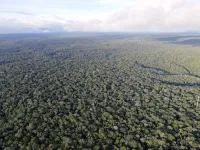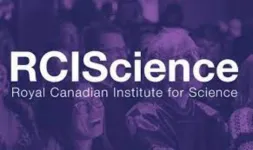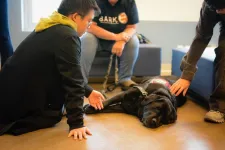(Press-News.org) CAMBRIDGE, MA -- To make our way through the world, our brain must develop an intuitive understanding of the physical world around us, which we then use to interpret sensory information coming into the brain.
How does the brain develop that intuitive understanding? Many scientists believe that it may use a process similar to what’s known as “self-supervised learning.” This type of machine learning, originally developed as a way to create more efficient models for computer vision, allows computational models to learn about visual scenes based solely on the similarities and differences between them, with no labels or other information.
A pair of studies from researchers at the K. Lisa Yang Integrative Computational Neuroscience (ICoN) Center at MIT offers new evidence supporting this hypothesis. The researchers found that when they trained models known as neural networks using a particular type of self-supervised learning, the resulting models generated activity patterns very similar to those seen in the brains of animals that were performing the same tasks as the models.
The findings suggest that these models are able to learn representations of the physical world that they can use to make accurate predictions about what will happen in that world, and that the mammalian brain may be using the same strategy, the researchers say.
“The theme of our work is that AI designed to help build better robots ends up also being a framework to better understand the brain more generally,” says Aran Nayebi, a postdoc in the ICoN Center. “We can’t say if it’s the whole brain yet, but across scales and disparate brain areas, our results seem to be suggestive of an organizing principle.”
Nayebi is the lead author of one of the studies, co-authored with Rishi Rajalingham, a former MIT postdoc now at Meta Reality Labs, and senior authors Mehrdad Jazayeri, an associate professor of brain and cognitive sciences and a member of the McGovern Institute for Brain Research; and Robert Yang, an assistant professor of brain and cognitive sciences and an associate member of the McGovern Institute. Ila Fiete, director of the ICoN Center, a professor of brain and cognitive sciences, and an associate member of the McGovern Institute, is the senior author of the other study, which was co-led by Mikail Khona, an MIT graduate student, and Rylan Schaeffer, a former senior research associate at MIT.
Both studies will be presented at the 2023 Conference on Neural Information Processing Systems (NeurIPS) in December.
Modeling the physical world
Early models of computer vision mainly relied on supervised learning. Using this approach, models are trained to classify images that are each labeled with a name — cat, car, etc. The resulting models work well, but this type of training requires a great deal of human-labeled data.
To create a more efficient alternative, in recent years researchers have turned to models built through a technique known as contrastive self-supervised learning. This type of learning allows an algorithm to learn to classify objects based on how similar they are to each other, with no external labels provided.
“This is a very powerful method because you can now leverage very large modern data sets, especially videos, and really unlock their potential,” Nayebi says. “A lot of the modern AI that you see now, especially in the last couple years with ChatGPT and GPT-4, is a result of training a self-supervised objective function on a large-scale dataset to obtain a very flexible representation.”
These types of models, also called neural networks, consist of thousands or millions of processing units connected to each other. Each node has connections of varying strengths to other nodes in the network. As the network analyzes huge amounts of data, the strengths of those connections change as the network learns to perform the desired task.
As the model performs a particular task, the activity patterns of different units within the network can be measured. Each unit’s activity can be represented as a firing pattern, similar to the firing patterns of neurons in the brain. Previous work from Nayebi and others has shown that self-supervised models of vision generate activity similar to that seen in the visual processing system of mammalian brains.
In both of the new NeurIPS studies, the researchers set out to explore whether self-supervised computational models of other cognitive functions might also show similarities to the mammalian brain. In the study led by Nayebi, the researchers trained self-supervised models to predict the future state of their environment across hundreds of thousands of naturalistic videos depicting everyday scenarios.
“For the last decade or so, the dominant method to build neural network models in cognitive neuroscience is to train these networks on individual cognitive tasks. But models trained this way rarely generalize to other tasks,” Yang says. “Here we test whether we can build models for some aspect of cognition by first training on naturalistic data using self-supervised learning, then evaluating in lab settings.”
Once the model was trained, the researchers had it generalize to a task they call “Mental-Pong.” This is similar to the video game Pong, where a player moves a paddle to hit a ball traveling across the screen. In the Mental-Pong version, the ball disappears shortly before hitting the paddle, so the player has to estimate its trajectory in order to hit the ball.
The researchers found that the model was able to track the hidden ball’s trajectory with accuracy similar to that of neurons in the mammalian brain, which had been shown in a previous study by Rajalingham and Jazayeri to simulate its trajectory — a cognitive phenomenon known as “mental simulation.” Furthermore, the neural activation patterns seen within the model were similar to those seen in the brains of animals as they played the game — specifically, in a part of the brain called the dorsomedial frontal cortex. No other class of computational model has been able to match the biological data as closely as this one, the researchers say.
“There are many efforts in the machine learning community to create artificial intelligence,” Jazayeri says. “The relevance of these models to neurobiology hinges on their ability to additionally capture the inner workings of the brain. The fact that Aran’s model predicts neural data is really important as it suggests that we may be getting closer to building artificial systems that emulate natural intelligence.”
Navigating the world
The study led by Khona, Schaeffer, and Fiete focused on a type of specialized neurons known as grid cells. These cells, located in the entorhinal cortex, help animals to navigate, working together with place cells located in the hippocampus.
While place cells fire whenever an animal is in a specific location, grid cells fire only when the animal is at one of the vertices of a triangular lattice. Groups of grid cells create overlapping lattices of different sizes, which allows them to encode a large number of positions using a relatively small number of cells.
In recent studies, researchers have trained supervised neural networks to mimic grid cell function by predicting an animal’s next location based on its starting point and velocity, a task known as path integration. However, these models hinged on access to privileged information about absolute space at all times — information that the animal does not have.
Inspired by the striking coding properties of the multiperiodic grid-cell code for space, the MIT team trained a contrastive self-supervised model to both perform this same path integration task and represent space efficiently while doing so. For the training data, they used sequences of velocity inputs. The model learned to distinguish positions based on whether they were similar or different — nearby positions generated similar codes, but further positions generated more different codes.
“It’s similar to training models on images, where if two images are both heads of cats, their codes should be similar, but if one is the head of a cat and one is a truck, then you want their codes to repel,” Khona says. “We’re taking that same idea but applying it to spatial trajectories.”
Once the model was trained, the researchers found that the activation patterns of the nodes within the model formed several lattice patterns with different periods, very similar to those formed by grid cells in the brain.
“What excites me about this work is that it makes connections between mathematical work on the striking information-theoretic properties of the grid cell code and the computation of path integration,” Fiete says. “While the mathematical work was analytic — what properties does the grid cell code possess? — the approach of optimizing coding efficiency through self-supervised learning and obtaining grid-like tuning is synthetic: It shows what properties might be necessary and sufficient to explain why the brain has grid cells.”
###
The research was funded by the K. Lisa Yang ICoN Center, the National Institutes of Health, the Simons Foundation, the McKnight Foundation, the McGovern Institute, and the Helen Hay Whitney Foundation.
END
The brain may learn about the world the same way some computational models do
Two studies find “self-supervised” models, which learn about their environment from unlabeled data, can show activity patterns similar to those of the mammalian brain.
2023-10-30
ELSE PRESS RELEASES FROM THIS DATE:
Largest brain autopsy study of female intimate partner violence decedents reveals brain injury pathology unlike that seen among male contact sports athletes
2023-10-30
The largest brain autopsy study of women who had experienced intimate partner violence reveals substantial vascular and white matter damage in the brain, but no evidence of chronic traumatic encephalopathy (CTE), the neurodegenerative disease recognized among male contact sports athletes who sustain repeated head trauma.
The international collaboration, led by a team from the Brain Injury Research Center of Mount Sinai in collaboration with the New York City Office of the Chief Medical Examiner, appears in the most recent issue of Acta Neuropathologica.
Importantly, ...
Soy expansion in Brazil linked to increase in childhood leukemia deaths
2023-10-30
URBANA, Ill. – Over the past decades, Brazil has become the world’s leading soybean producer, as well as the leading consumer of pesticides. Despite concerns about potential public health consequences, little is known about the effects of pesticide exposure in the general population. A new study from the University of Illinois Urbana-Champaign in collaboration with the University of Denver and University of Wisconsin-Madison looks at how soy expansion and increased pesticide use in Brazil’s Cerrado and Amazon biomes correlate with increased childhood cancer mortality.
“The Brazilian Amazon region is undergoing a transition ...
Amazon deforestation linked to long distance climate warming
2023-10-30
Deforestation in the Amazon causes land surfaces up to 100 kilometres away to get warmer, according to a new study.
The research, by a team of British and Brazilian scientists, led by Dr Edward Butt at the University of Leeds, suggests that tropical forests play a critical role in cooling the land surface - and that effect can play out over considerable distances.
It is known that when tropical forests are cleared, the climate in the immediate vicinity gets warmer.
In this latest study, the researchers wanted to know if deforestation in the Amazon was resulting in climate warming further afield, and the study examined the impact of forest loss on sites up to ...
NYU Abu Dhabi researchers reveal how common desert shrub efficiently harvests water from the air
2023-10-30
Abu Dhabi, UAE, October 2023: A team of scientists, led by Post-Doctoral Associate Marieh Al-Handawi and Professor of Chemistry Panče Naumov from NYU Abu Dhabi’s Smart Materials Lab and NYU Abu Dhabi Institute’s Center for Smart Engineering Materials (CSEM) has revealed the mechanism a desert plant native to the United Arab Emirates uses to capture moisture from the desert air in order to survive. The identification of this unique mechanism, in which the plant excretes salts to extract and condense water onto the surface of its leaves, has the potential to inspire ...
Royal Canadian Institute for Science recognizes the unsung heroes of science communication
2023-10-30
The Royal Canadian Institute for Science (RCIScience) awards the 2023 Sandford Fleming Medal for Excellence in Science Communication to independent science writer Terry Collins and the William Edmond Logan Award to the team behind CBC Radio's national weekly science program, Quirks & Quarks.
A knowledge translator for over 27 years, Terry Collins' reporting has been picked up by journalists in Canada and worldwide, awakening public interest in and deepening understanding of diverse sciences, fostering political will and mobilizing resources for change.
Nominator Dr. Peter A. Singer, former Special Advisor to the Director-General of the World Health Organization, ...
Institute for Systems Biology and NED Biosystems announce collaboration to show how cancer’s onset may be reversed
2023-10-30
SEATTLE – Leroy Hood, MD, PhD, co-founder of Seattle’s Institute for Systems Biology (ISB) and a pioneer in systems biology, and Rebecca Lambert, founder and CEO of NED Biosystems, Inc. (NED), a public benefit corporation that is developing the first oral “systems treatment” for cancer, have entered into a memorandum of understanding to collaborate on a clinical trial to show how cancer’s onset may be reversed.
NED’s cancer treatment, NED-170, takes a systems approach that combines repurposed, oral agents that are well documented in humans to affect critical cancer disease-driver processes at doses that lack customary toxicity and side effects.
“A ...
Women with physical disabilities are less likely to be screened for cervical cancer than women without disabilities
2023-10-30
Around 11,500 new cases of cervical cancer are diagnosed each year in the United States, according to the Centers for Disease Control (CDC). The CDC tracks cervical cancer rates by age, race, and ethnicity, but not by disability type. A 2022 study found that women with disabilities may encounter multiple social and economic barriers to accessing reproductive health care, and a lack of timely access to cervical cancer screening may lead to delayed diagnosis and treatment for cervical cancer.
According to research by Mason PhD in Public Health ...
Department of Energy announces $11.4 million for research on quantum information science for fusion energy sciences
2023-10-30
WASHINGTON, D.C. - Today, the U.S. Department of Energy (DOE) announced $11.4 million for six projects in quantum information science (QIS) with relevance to fusion and plasma science.
The Fusion Energy Sciences (FES) program supports fundamental research to expand the understanding of matter at very high temperatures and densities and to build the scientific foundation needed to develop a fusion energy source. The QIS portfolio within FES supports research opportunities outlined in the 2018 Fusion Energy Sciences Roundtable on Quantum Information Science report. It includes science and technology thrusts where QIS might have a transformative impact on FES ...
RIT scientists receive grant to expand work on a sign language lexicon for chemistry
2023-10-30
A team of scientists at Rochester Institute of Technology will expand its work after receiving a large grant from the National Science Foundation to make chemistry more accessible for students who rely on American Sign Language interpreters in class.
Christina Goudreau Collison, professor in the School of Chemistry and Materials Science; Jennifer Swartzenberg, senior lecturer in the National Technical Institute for the Deaf’s Department of Science and Mathematics; Lea Michel, professor in the School of Chemistry and Materials Science; and Pepsi Holmquist, visiting assistant professor in NTID’s Department of Science and Mathematics, have been awarded nearly $380,000 ...
Canine cuddles can comfort equally across all genders
2023-10-30
While there are a number of studies demonstrating that dog therapy programs can improve a person’s social and emotional wellbeing, many typically have a disproportionate number of female participants.
Recent research led by Dr. John-Tyler Binfet, an Associate Professor in UBC Okanagan’s School of Education and Director of Building Academic Retention through K9s (BARK), evaluated if there are gender differences in wellbeing by setting up separate dog therapy sessions for those who identified as female, male and gender diverse participants.
Dr. Binfet has conducted numerous studies on the benefits of canine therapy, but to his knowledge, ...
LAST 30 PRESS RELEASES:
Tracing the quick synthesis of an industrially important catalyst
New software sheds light on cancer’s hidden genetic networks
UT Health San Antonio awarded $3 million in CPRIT grants to bolster cancer research and prevention efforts in South Texas
Third symposium spotlights global challenge of new contaminants in China’s fight against pollution
From straw to soil harmony: International team reveals how biochar supercharges carbon-smart farming
Myeloma: How AI is redrawing the map of cancer care
Manhattan E. Charurat, Ph.D., MHS invested as the Homer and Martha Gudelsky Distinguished Professor in Medicine at the University of Maryland School of Medicine
Insilico Medicine’s Pharma.AI Q4 Winter Launch Recap: Revolutionizing drug discovery with cutting-edge AI innovations, accelerating the path to pharmaceutical superintelligence
Nanoplastics have diet-dependent impacts on digestive system health
Brain neuron death occurs throughout life and increases with age, a natural human protein drug may halt neuron death in Alzheimer’s disease
SPIE and CLP announce the recipients of the 2025 Advanced Photonics Young Innovator Award
Lessons from the Caldor Fire’s Christmas Valley ‘Miracle’
Ant societies rose by trading individual protection for collective power
Research reveals how ancient viral DNA shapes early embryonic development
A molecular gatekeeper that controls protein synthesis
New ‘cloaking device’ concept to shield sensitive tech from magnetic fields
Researchers show impact of mountain building and climate change on alpine biodiversity
Study models the transition from Neanderthals to modern humans in Europe
University of Phoenix College of Doctoral Studies releases white paper on AI-driven skilling to reduce burnout and restore worker autonomy
AIs fail at the game of visual “telephone”
The levers for a sustainable food system
Potential changes in US homelessness by ending federal support for housing first programs
Vulnerability of large language models to prompt injection when providing medical advice
Researchers develop new system for high-energy-density, long-life, multi-electron transfer bromine-based flow batteries
Ending federal support for housing first programs could increase U.S. homelessness by 5% in one year, new JAMA study finds
New research uncovers molecular ‘safety switch’ shielding cancers from immune attack
Bacteria resisting viral infection can still sink carbon to ocean floor
Younger biological age may increase depression risk in older women during COVID-19
Bharat Innovates 2026 National Basecamp Showcases India’s Most Promising Deep-Tech Ventures
Here’s what determines whether your income level rises or falls
[Press-News.org] The brain may learn about the world the same way some computational models doTwo studies find “self-supervised” models, which learn about their environment from unlabeled data, can show activity patterns similar to those of the mammalian brain.




